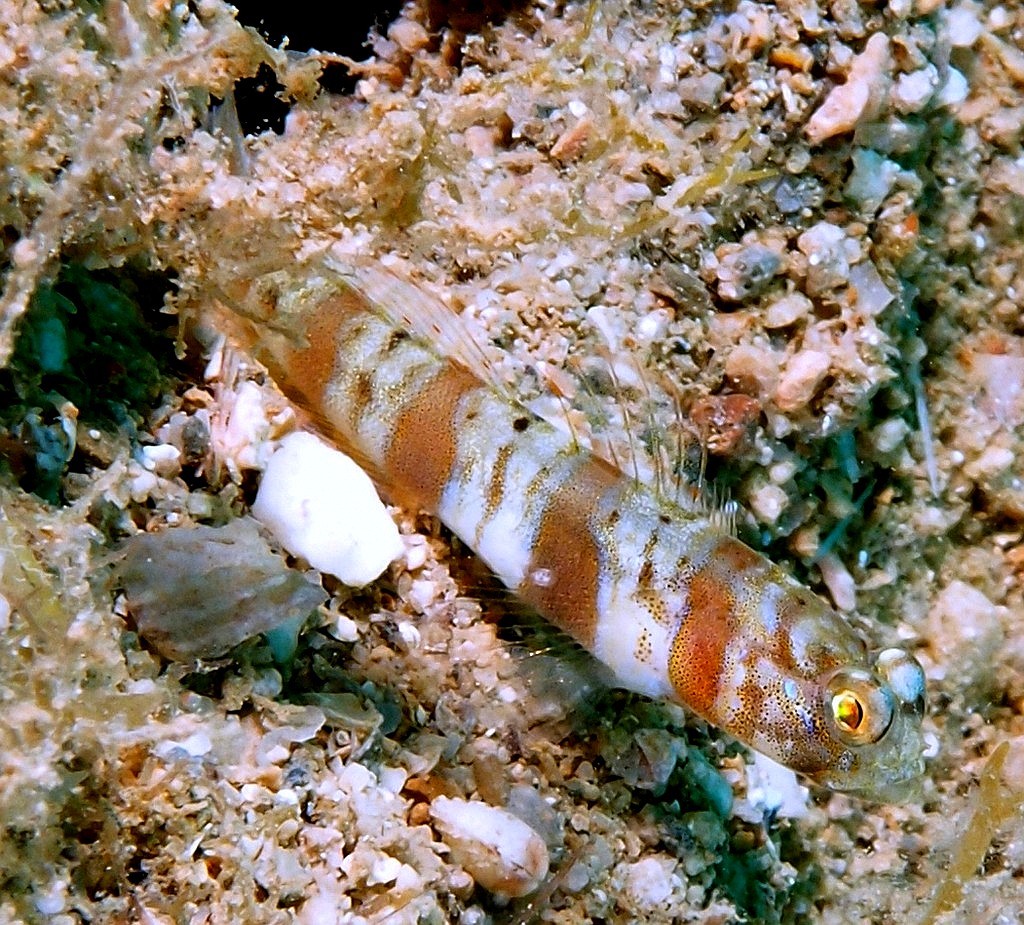AMBLYELEOTRIS RUBRIMARGINATA - (MOHLMANN & RANDALL, 2002)
Actinopterygii (Gigaclass) > Actinopteri (Class) > Teleostei (Subclass) > Gobiiformes (Order) > Gobioidei (Suborder) > Gobiidae (Family) > Gobiinae (Subfamily) > Amblyeleotris (Genus)
Cette photographie montre un individu n'ayant pas les couleurs typiques de l'espèce. Par contre on retrouve des points rouges sur le sommet des épines dorsales et les taches sombres (même si elles sont un peu estompées) derrière les yeux.
Redmargin shrimpgoby,
Description
Dorsal spines (total): 7; Dorsal soft rays (total): 13-14; Anal spines: 1; Anal soft rays: 14 - 15. Dorsal spines (total): 7; Dorsal soft rays (total): 13-14; Anal spines: 1; Anal soft rays: 14 - 15. Characterized by whitish body color with 5-6 light brown bars, dark speckles/lighter mottling between bars; dorsal fins and upper caudal fin with red margin; pelvic fins joined by membrane, about 10% of basal part of fins covered; midline of nape, chest and base of pectoral fin without scales; longitudinal scale series 77-94; greatest depth of body 5.6-6.7 in SL; pointed caudal fin, longer than head, 2.3-3.2 in SL. Max length : 11.0 cm. Depth range 2 - 20 m.
Etymology
Amblyeleotris: from Greek, amblys or amblus = dull (blade: not sharp), blunt, obtuse + from the Greek name of a fish, eleōtris, found in the swampy waters of the Nile (Egypt) (from the Greek, eleios = who lives in the marshes). The name Eleotris appears for the first time in Déipnosophistes, a compilation of anecdotes and quotations from ancient authors, written by a scholar and grammarian Greek, Athenaeus of Naucratis (about 170-223 AD). In 1763, the Dutch naturalist and collector Laurentius Theodorus Gronovius (1730-1777) used this name to designate a new genus of fish. The authorship of the genre escapes him because his work was rejected by the scientific community of the time. The genre should have returned to the doctor, entomologist and naturalist of Italian culture, Giovanni Antonio Scopoli (1723-1788) but the late recognition of his work made him lose the authorship of the name. Today the genus, Eleotris, is attributed to Bloch & Schneider, 1801.
Cette photographie montre un individu n'ayant pas les couleurs typiques de l'espèce. Par contre on retrouve des points rouges sur le sommet des épines dorsales et les taches sombres (même si elles sont un peu estompées) derrière les yeux.
Redmargin shrimpgoby,
Description
Dorsal spines (total): 7; Dorsal soft rays (total): 13-14; Anal spines: 1; Anal soft rays: 14 - 15. Dorsal spines (total): 7; Dorsal soft rays (total): 13-14; Anal spines: 1; Anal soft rays: 14 - 15. Characterized by whitish body color with 5-6 light brown bars, dark speckles/lighter mottling between bars; dorsal fins and upper caudal fin with red margin; pelvic fins joined by membrane, about 10% of basal part of fins covered; midline of nape, chest and base of pectoral fin without scales; longitudinal scale series 77-94; greatest depth of body 5.6-6.7 in SL; pointed caudal fin, longer than head, 2.3-3.2 in SL. Max length : 11.0 cm. Depth range 2 - 20 m.
Etymology
Amblyeleotris: from Greek, amblys or amblus = dull (blade: not sharp), blunt, obtuse + from the Greek name of a fish, eleōtris, found in the swampy waters of the Nile (Egypt) (from the Greek, eleios = who lives in the marshes). The name Eleotris appears for the first time in Déipnosophistes, a compilation of anecdotes and quotations from ancient authors, written by a scholar and grammarian Greek, Athenaeus of Naucratis (about 170-223 AD). In 1763, the Dutch naturalist and collector Laurentius Theodorus Gronovius (1730-1777) used this name to designate a new genus of fish. The authorship of the genre escapes him because his work was rejected by the scientific community of the time. The genre should have returned to the doctor, entomologist and naturalist of Italian culture, Giovanni Antonio Scopoli (1723-1788) but the late recognition of his work made him lose the authorship of the name. Today the genus, Eleotris, is attributed to Bloch & Schneider, 1801.
Rubrimarginata: Latin for red and marginata for edge, in reference to the distinctive bright red margin of the dorsal fins.
Original description: Amblyeleotris rubrimarginata Mohlmann & Randall, 2002 - Type locality: Watson's Bay, Great Barrier Reef, Lizard Island, Queensland, Australia, depth 12 meters.
Distribution
Western Pacific: East Indian region to New Caledonia.
Biology
Amblyeleotris rubrimarginata is found on sandy to silty sandy substrates associated with coral reefs or sea grass beds from depths of 3 to 26 m and living in association with alpheid shrimps. A single or pair of gobies may occupy the burrow, generally with a pair of alpheid shrimps.
Similar species
This species is most similar to Amblyeleotris japonica (Takagi, 1957) which has similar dorsal and anal-fin ray counts and pelvic-fin structure. Amblyeleotris japonica (Takagi, 1957) has a lower number of scales in longitudinal series (69-78) compared to Amblyeleotris rubrimarginata (77-94). The red margin on the dorsal and caudal fins and the black spot behind the eye are the most conspicuous color markings that serve to separate Amblyeleotris rubrimarginata from other species of the genus.
Original description: Amblyeleotris rubrimarginata Mohlmann & Randall, 2002 - Type locality: Watson's Bay, Great Barrier Reef, Lizard Island, Queensland, Australia, depth 12 meters.
Distribution
Western Pacific: East Indian region to New Caledonia.
Biology
Amblyeleotris rubrimarginata is found on sandy to silty sandy substrates associated with coral reefs or sea grass beds from depths of 3 to 26 m and living in association with alpheid shrimps. A single or pair of gobies may occupy the burrow, generally with a pair of alpheid shrimps.
Similar species
This species is most similar to Amblyeleotris japonica (Takagi, 1957) which has similar dorsal and anal-fin ray counts and pelvic-fin structure. Amblyeleotris japonica (Takagi, 1957) has a lower number of scales in longitudinal series (69-78) compared to Amblyeleotris rubrimarginata (77-94). The red margin on the dorsal and caudal fins and the black spot behind the eye are the most conspicuous color markings that serve to separate Amblyeleotris rubrimarginata from other species of the genus.
